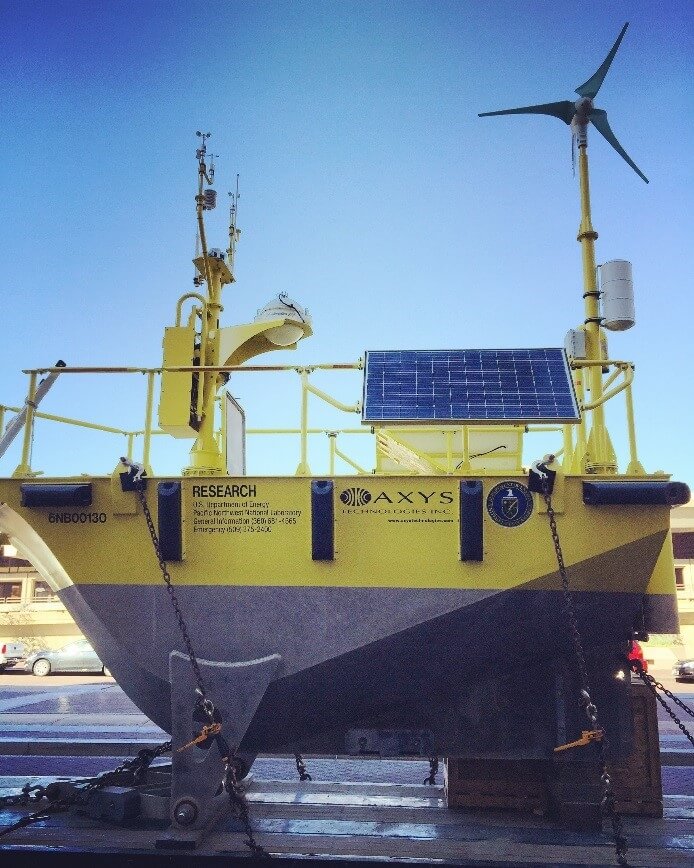
Seen here at a visit to the DOE’s headquarters in Washington D.C., the AXYS WindSentinel buoy is now deployed at its final destination off the coast of New Jersey. (Photo: U.S. Department of Energy)
Editor’s note: The Energy Department (DOE) recently deployed the AXYS WindSentinel buoy off the coast of Atlantic City, New Jersey. The buoy is intended to help researchers gather data for planning future offshore wind projects in the U.S. Here’s the release from the DOE.
The United States is one step closer to harnessing the vast amount of potential wind energy available offshore. The DOE has deployed one of two AXYS WindSentinel buoy owned by the Department off the waters of New Jersey. The vessel can operate autonomously and is uniquely equipped with instrumentation to help researchers gather necessary data needed to plan future offshore wind deployments.
As a new U.S. renewable energy frontier, limited information is available about ocean-based wind resources, especially at the heights at which wind turbines operate. One of the key instruments on top of the buoy is a LiDAR (Light Detection and Ranging) device that shoots a series of lasers 650 feet into the sky and measures their reflection to characterize wind speeds at various altitudes.
The buoy also uses additional meteorological and oceanographic instruments that record air and sea surface temperature, barometric pressure, relative humidity, wave height, and period, water salinity, and subsurface ocean currents. In December 2014, researchers from Pacific Northwest National Laboratory deployed the first specialized Energy Department buoy near Virginia Beach, Virginia.
Earlier this fall, the buoy was on display at Energy Department headquarters in Washington, DC for an open-hatch buoy tour event. Curious onlookers got to see it firsthand and learn about its capabilities before the vessel was taken to its staging facility in Avalon, New Jersey, where it underwent extensive preparation and pre-deployment testing
A crucial factor in the development, siting, and operation of a wind farm is the ability to assess and characterize available wind resources. Buoys have the unique ability to show a clearer picture of air-sea interactions and the site-specific impact they have on offshore wind turbine power production. Data from the buoys help validate wind predictions derived from computer models, which have thus far relied on very limited information. By providing site-specific wind speeds and power production estimates, the data helps improve offshore turbine development and reduce barriers to private investment in the offshore wind industry.
With 80% of America’s electricity demand coming from coastal states, developing offshore wind resources plays an important role in meeting America’s energy needs. The Wind Program supports efforts to accurately define, measure, and forecast the nation’s land-based and offshore wind resources.
The program is leading a portfolio of wind integration, transmission, and resource assessment and characterization projects that will help the industry understand how to reliably integrate large quantities of wind energy into system operations, as well as develop capabilities that will enable these new wind installations to actively improve the quality of electric grid.
The Energy Department’s WindSentinel wind resource characterization buoys will provide long-term offshore wind profile data that will support research needed to accelerate the utilization of offshore wind energy in the United States. The WindSentinel is operating at full capacity and is transmitting data to shore every 10 minutes; step-by-step directions to access data from DOE WindSentinel buoys can be found here.
To learn more about the Department’s offshore wind energy research efforts, read the National Offshore Wind Energy Grid Interconnection Study and visit the Offshore Wind Advanced Technology Demonstration Projects web page.
Department of Energy
www.energy.gov
Filed Under: News, Offshore wind




